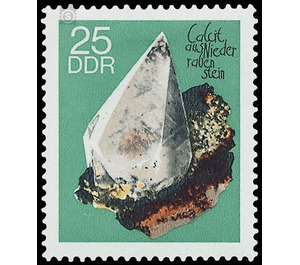Minerals from the collections of the Freiberg Mining Academy - Germany / German Democratic Republic 1969 - 25 Pfennig
Theme: Geology & Geography
| Country | Germany / German Democratic Republic |
| Issue Date | 1969 |
| Face Value | 25.00 |
| Color | green |
| Perforation | K 14 |
| Printing Type | Photogravure |
| Stamp Type | Postage stamp |
| Item Type | Stamp |
| Chronological Issue Number | 1214 |
| Chronological Chapter | GER-DDR |
| SID | 70725 |
| In 11 Wishlists | |
Beautiful minerals of the GDR The Ministry of Posts and Telecommunications of the GDR publishes a series with six multicolored special postage stamps on which beautiful minerals from the German Democratic Republic are depicted. Minerals of the GDR Many types and varieties of minerals have been described in the scientific literature for the first time in the Ore Mountains, the Thuringian Forest and the Harz. A large number of minerals occur in the territory of the German Democratic Republic in excellent quality and special beauty. For these reasons, minerals of our homeland can be found in all the major collections in the world. As in recent years again and again interesting findings of minerals were discovered in the GDR, the issue of a stamp series with mineral motifs is of particular relevance. The minerals displayed on the stamps were all found on the territory of the GDR today. The steps are stored in the mineralogical collection of the Geosciences section of the Bergakademie Freiberg. 25-pfennig value: calcite CaCO3 from Niederrabenstein near Karl-Marx-Stadt (No. 13 208) Calcite is a mineral which is very widespread in nature. Its color is mostly milk white, occasionally greyish, yellowish, reddish or brownish tinted. More rare is the colorless, water-clear variety, which is called Doppelspat because of the birefringent optical properties. The crystal forms of calcite are extremely diverse. Very often, acute-angled, tabular or columnar crystals appear. The crystal pictured on the mark is a scale oeder of approximately 60x30 mm, grown on quartz. The illustrated minerals give a little insight into the richness and beauty of the mineral deposits of the GDR. The exhibitions of the mineralogical collections at the Bergakademie in Freiberg (Saxony) and the Humboldt University in Berlin provide a much broader overview of this area of nature.


